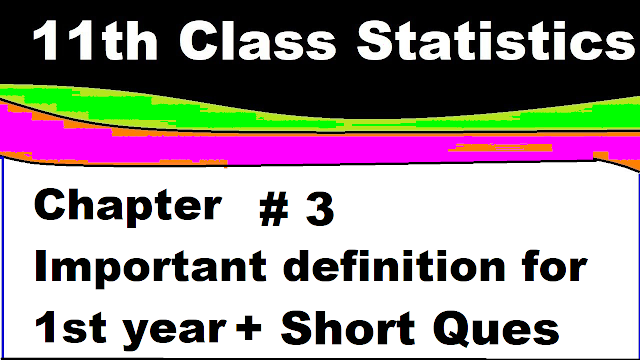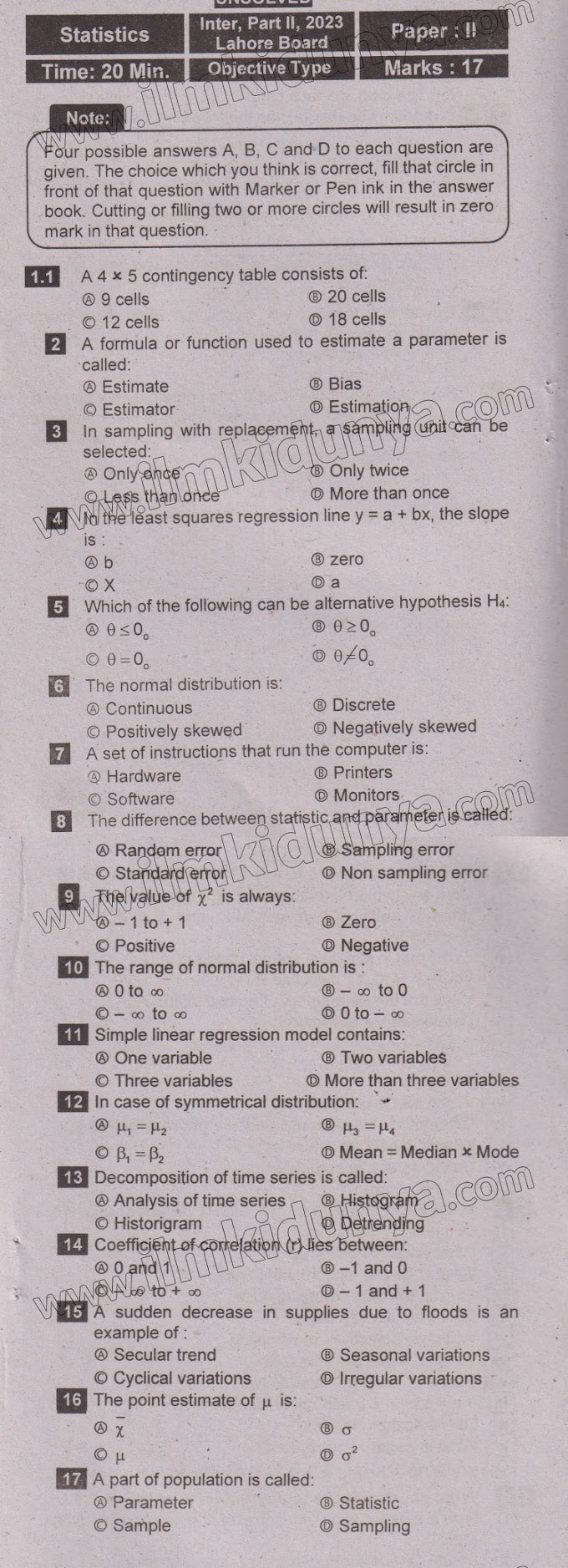Here
you can see the important definitions of chapter3 that is Measure of Location
Title: 11th class statistics important definitons for chapter 3 and short questions|| 1st year class statistics
chapter 3 :Measure of Location
(IMPORTANT SHORT QUESTIONS) CHAPTER # 3
|
Definitions |
Answers |
||||||||||||
|
1) Define Mean. |
It is obtained by dividing sum of values by their number. It is denoted by A.M OR . |
||||||||||||
|
2) Define Median. |
It is a value that divides an arranged data into two equal parts. It is denoted by Med or . |
||||||||||||
|
3) What are the merits of Mode? |
1) It is easy to understand and compute. |
||||||||||||
|
4) What is the formula of Arithmetic Mean in Group Data? |
|
||||||||||||
|
5) Give merits of Median. |
· It is very easy to calculate and is readily understood. · Median is not affected by the extreme values. |
||||||||||||
|
6) Give Empirical relation between Mean, Median and Mode. |
Empirical relation is of two types: i-Symmetrical In which Mean=Med=Mode ii-Skewed There are two types of skewed distribution (a) Positively skewed. Mean>Med>Mode (b)Negatively Skewed Mean<Med<Mode For moderately skewed distribution the following formula holds Mode =3Med-2Mean |
||||||||||||
|
7) Describe the qualities of a good average. |
(i) It should be rigidly defined. (ii) It should be based on all the observations of the series. (iii) It should be capable of further algebraic treatment. (v) It should not be affected by fluctuations of sampling. |
||||||||||||
|
8) Find out arithmetic mean. Given åx = 308 and n=7 |
|
||||||||||||
|
9) Compute the median for the following Data: 3,11,7,4,10 and 12. |
Arranged data: 3, 4, 7,10 ,11,12
|
||||||||||||
|
10) Explain the concept of “Weighted Arithmetic Mean” |
When all the values are not equally important then we assign them certain numerical values which are technically called weights. Weighted mean denoted by can be defined as
Where W= weight
|
||||||||||||
|
11) Define Median. |
The value that divides an arranged data into two equal parts is called median. |
||||||||||||
|
12) Find A.M given that D = x –45, ∑D = 25, and n = 50 |
As D=x-45 A=45
|
||||||||||||
|
13) For a certain frequency distribution, the value of Mean is 15 and Median is 20. What will be the value of Mode? |
As Mode =3Med-2Mean Mode =3(20)-2(15) Mode =60-30 Mode =30 |
||||||||||||
|
14) Define measures of central tendency. |
Measure of Central tendency is defined as “the statistical measure that identifies a single value as representative of an entire distribution .e.g. mean, median, mode, etc. OR A measure of central tendency is a measure that tells us where the middle of a bunch of data lies. The three most common measures of central tendency are the mean, the median, and the mode. |
||||||||||||
|
15) Give some merits of arithmetic mean. |
· It is rigidly defined. · It is easy to calculate and simple to follow. · It is based on all the observations. · It is determined for almost every kind of data. · It is finite and not indefinite. · It is readily put to algebraic treatment. · It is least affected by fluctuations of sampling. |
||||||||||||
|
16) What is the formula of median in group data? |
|
||||||||||||
|
17) Fm = 20 F1=15 F2 =17 L=19.5 h=5, find mode. |
|
||||||||||||
|
18) Define mode giving example. |
The most repeated or the most common or the most frequent value of the data is called mode. It is denoted by . e.g for Data:2,7,5,87,9,3,2,9 mode =2 |
||||||||||||
|
19) Enlist the desirable qualities of a good average. |
(i) It should be rigidly defined. (ii) It should be based on all the observations of the series. (iii) It should be capable of further algebraic treatment. · (v) It should not be affected by fluctuations of sampling. |
||||||||||||
|
20) In a moderately skewed distribution median is 70 and Mean is 76. find the value of mode |
As Mode =3Med-2Mean Mode =3(70)-2(76) Mode =210-152 Mode =58 |
||||||||||||
|
21) For a certain distribution if ∑ (x – 15) = 12, ∑ (x – 18) = 0 and ∑ (x – 21) = 10 What is the value of mean and why? |
By the property of mean ..............1 And ∑ (x – 18) = 0 ..............2 By comparing 1 and 2 we get =18 |
||||||||||||
|
22) If for 50 observation ∑(x – 23) = -17, then find the value of mean.
|
Given ∑(x – 23) = -17 or∑D = -17 A =23
|
||||||||||||
|
23) Write the names of any two types of ‘Average’. |
(i) Mean (ii) mode |
||||||||||||
|
24) Find Median of the values : 10, 16, 12,17,13,14,11,15,18 |
Arranged Data: 10,11,12,13,14,15,16,17,18
|
||||||||||||
|
25) Write the names of any two methods for calculating Arithmetic Mean. |
(i)Direct Method (ii)Coddling Method |
||||||||||||
|
26) Write any two demerits of Mode. |
(i)Mode is ill-defined in case of bi-modal, multi-modal series. (ii) It is not capable of further algebraic treatment. (iii) Mode is affected to a great extent by the fluctuations of sampling. |
||||||||||||
|
27) Define positive skewed distribution. |
The distribution is positively skewed if the right tail of a Frequency Polygon curve of a distribution is longer than left tail. OR The distribution is positively skewed if Mean >Med>Mode |
||||||||||||
|
28) Give two properties of “Arithmetic Mean” |
i. The sum of deviations of values from mean is always zero i.e.
ii. The sum of square deviations of values from mean is always minimum i.e. Where “A” is any constant other than mean. |
||||||||||||
|
29) Find A.M given that x = 10 + 5u, ∑fu = 46 and n = 125 |
|
||||||||||||
|
30) Find Mode for the following data 2,4,5,6,4,7,6 and 10 |
Mode =4,6 |
||||||||||||
|
31) x and y are linearly related by the equation Find , if = 3
|
|
||||||||||||
|
32)Explain relationship among Mean Median and Mode, When distribution is symmetrical. |
when distribution is symmetrical then following relationship hold among Mean Median and Mode Mean = Med =Mode |
||||||||||||
|
33) Give demerits of arithmetic mean. |
· The arithmetic mean is highly affected by extreme values. · It cannot average the ratios and percentages properly. · It is not an appropriate average for highly skewed distributions. · It cannot be computed accurately if any item is missing. · The mean sometimes does not coincide with any of the observed value. |
||||||||||||
|
34) Write any two demerits of median. |
· It is not rigidly defined. · To find a mode array is necessary but it is very difficult to arrange a large data. |
||||||||||||
|
35) A variable ‘Y’ is determined from the variable ‘X’ by the equation Y=10-4X.Find y when X=-1,-2,0,1,2 |
|
||||||||||||
|
36)if x1=2,x2=8, show that A.M>G.M>.H.M |
|
||||||||||||
|
37) Why is difficult to calculate geometric mean for these values (i) 0,4,8 (ii) 3,5.-2 |
(i) We know that if any value equals to zero then G.M is not possible. (ii) We know that if any value is negative then G.M is not possible. |
||||||||||||
|
38) Define geometric mean. |
The nth positive root of the product of n positive values is called geometric mean. It is denoted by G.M. Symbolically for ungroup data |
||||||||||||
|
39) Given that and n=5. Find mean. |
Since |
||||||||||||
|
40) Give various methods of computing arithmetic mean for group data. |
|
||||||||||||
|
41) Define deciles. |
Deciles The values that divide an arrayed data into ten equal parts are called quartiles. They are denoted by D1, D2, and D3 ...D9. Symbolically For ungroup Data
Where m = 1,2,3,4... 9 For group Data
Where Lower class boundary of Dm group h = class width of Dmgroup f = frequency of Dmgroup c = cumulative frequency of the class preceding the Dmgroup
Where m = 1,2,3,4... 9 |
Thanks for visiting this site.












0 Comments
Thanks for message us We shall approve it if you have oxygen like words for us